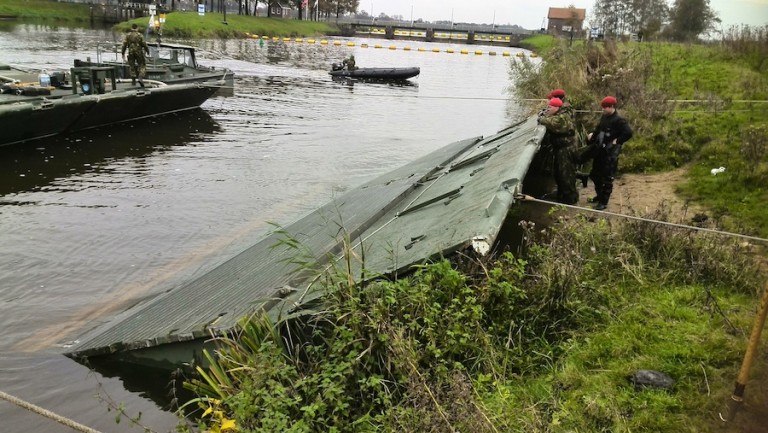BreachDefender as an Emergency Response Strategy
- 01 December 2020
- Francien Horrevorts
- Emergency Response
On Monday the 16th of November, our very first Polder2C’s webinar took place. Danny Janssen shared his latest research results about the BreachDefender as an Emergency Response Strategy.
The organising team were Marc Balemans, Dutch Ministry of Defense, Alexander Schmets, Dutch Defense Academy and Danny Janssen, TU Delft and the Dutch Defense Academy.
Danny Janssen is a PhD candidate and his research subject is The BreachDefender as emergency response strategy to prevent or postpone a levee breach. The main purpose of the webinar was to share the results of his work so far and to interact with fellow experts about future research and applications for the BreachDefender.

The BreachDefender
The BreachDefender is an emergency response strategy to prevent or postpone dike failure. Currently the BreachDefender is defined as a military pontoon folding bridge, used by the Dutch military, mainly for transportation of troops or tanks over water. When filling the pontoon with water instead of air, it can be applied to reinforce a weakened levee body to prevent or delay a levee breach. This exercise has already been done in 2016. However, it could not be determined whether the BreachDefender would really help during an emergency situation. One of the Polder2C’s objectives is to further research using the BreachDefender as an emergency response strategy.
BreachDefender Research
The main topic of Danny’s research is to find and verify technical applications of the BreachDefender. The Dutch Ministry of Defense has the task to support during national crises, such as a flooding crisis. The problem is that both defense and crisis managers do not know which equipment to apply to prevent or postpone levee breaches. It is necessary to know how to use their material as efficiently as possible to stop breaches in their early stages. And how to apply things that are not originally designed for emergency response. Danny’s research aims to give insight into how the BreachDefender can be used to stop breaches, to postpone levee failure to increase evacuation time and to advise for which scenarios the BreachDefender is appropriate. His research focuses on two scenarios.

First research scenario
The first scenario: local crest settlement leads to overflowing water. If the water level rises, it will normally flow through the settlement into the polder. The BreachDefender is applied to decrease the total amount of overflowing water. It can be applied before or after the breach and start of overflow. The BreachDefender is expected to reduce the total amount of water flowing through, which reduces the amount of eroded material. This will result in an increase of the total breach formation time. In the coming future Danny will start to test this scenario in FloodProofHolland, Delft. The main findings and lessons learned from the tests in FloodProofHolland will be used to conduct experiments in the Living Lab Hedwige-Prosperpolder with a real prototype at a later stage.
Second research scenario
The second scenario: due to damage in the ‘impermeable’ layer (grass cover), water is able to flow into the gap, leading to levee failure. Danny did several experiments for this scenario in the Hydraulic Lab in Delft. A homogeneous sand dike in which pressure sensors had been placed was constructed. The effect of the phreatic surface level in relation to a certain amount of steel plate coverage (replacement for the BreachDefender) on the outer slope of the levee was tested. Main lesson learned was that sealing of the outer slope of the levee with a steel plate can have an influence on the rate of change of the phreatic surface, but the steady state conditions remained more or less the same. For further research Danny will create a computer model to simulate more complex situations.
"The webinar had a great turnout, almost 30 experts with various backgrounds from Belgium, the United Kingdom and the Netherlands were present."
Marc Balemans, Dutch Ministry of Defense
Webinar was a success
The first ever webinar of Polder2C’s was organised because the Field Day in the polder had to be cancelled. The webinar brought together two worlds, the theoretical and the practical side of Emergency Response as both scientists and crisis managers joined in. It turned out to be a success and left the organisers with a taste for more. Danny: “It was a great thing to do, we have had positive responses during the webinar. And by including a small questionnaire with Mentimeter, we know that everyone is eager to learn more about the research and use of BreachDefender.”
